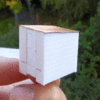LMS Signalbox (Ratio/Scratch)
AJC
Western Thunderer
Before the Bank Holiday weekend claims me in earnest (conference paper calls...), here are a couple of updates from the paintbox. First, the Bedford QL which, having sprouted a trafficator and sundry minor details - fewer than I might usually bother with, but who can tell? - and a coat of paint, slapped on over white primer.


The 'Mickey Mouse ears' of camouflage were fun to do but could, I suppose, be neater and more precise. After a decade or so in the elements I reckon that the black, sprayed over khaki/green would have worn largely away so I'm relatively unconcerned. Despite this I shall use some of the kit's transfers for unit markings and so on; as modellers living in a world full of text and labels I sometimes wonder why we are so sparing with them, enamel adverts apart, in miniature form. One of the smaller jobs remaining for South Junction is to create and add more signage away from the railway.
The other side of the fence needs its materiel too and here, happily, is Canal Junction cabin, finished with a dose of weathering. I'll be back in Somerset mid-September to install it (and the Bedford).

Adam


The 'Mickey Mouse ears' of camouflage were fun to do but could, I suppose, be neater and more precise. After a decade or so in the elements I reckon that the black, sprayed over khaki/green would have worn largely away so I'm relatively unconcerned. Despite this I shall use some of the kit's transfers for unit markings and so on; as modellers living in a world full of text and labels I sometimes wonder why we are so sparing with them, enamel adverts apart, in miniature form. One of the smaller jobs remaining for South Junction is to create and add more signage away from the railway.
The other side of the fence needs its materiel too and here, happily, is Canal Junction cabin, finished with a dose of weathering. I'll be back in Somerset mid-September to install it (and the Bedford).

Adam


































